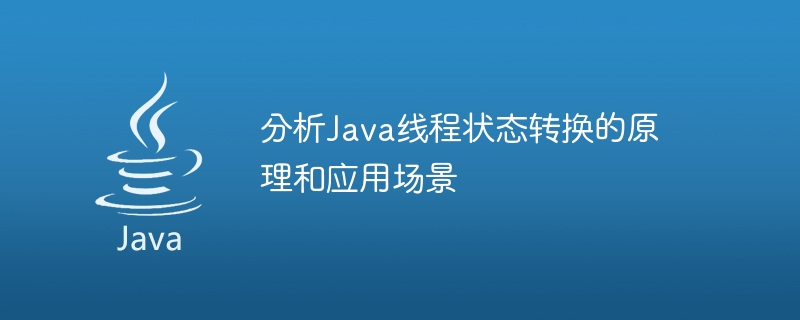

Java线程状态转换的原理和应用场景
引言:
Java作为一种多线程编程语言,使用线程可以实现并发执行,提高程序的执行效率。在Java中,线程的状态是非常重要的概念,它决定了线程可以执行的操作和被操作的状态。本文将从原理和应用场景两个方面来分析Java线程状态转换。
一、线程状态转换的原理
在Java中,线程有六种状态:New、Runnable、Blocked、Waiting、Timed Waiting和Terminated。线程状态是通过调用不同方法来实现转换的。
代码示例:
Thread thread = new Thread(); thread.start();
代码示例:
public class MyThread implements Runnable{
public void run(){
// 线程执行的代码逻辑
}
}
public class Main{
public static void main(String[] args){
MyThread myThread = new MyThread();
Thread thread = new Thread(myThread);
thread.start();
}
}代码示例:
public class MyThread implements Runnable{
public void run(){
synchronized (lock){
// 获取锁之后执行的代码逻辑
}
}
}
public class Main{
public static void main(String[] args){
MyThread myThread1 = new MyThread();
MyThread myThread2 = new MyThread();
Thread thread1 = new Thread(myThread1);
Thread thread2 = new Thread(myThread2);
thread1.start();
thread2.start();
}
}代码示例:
public class MyThread implements Runnable{
public void run(){
synchronized (lock){
try{
lock.wait(); // 等待其他线程的通知
}catch(InterruptedException e){
e.printStackTrace();
}
}
}
}
public class Main{
public static void main(String[] args){
MyThread myThread = new MyThread();
Thread thread = new Thread(myThread);
thread.start();
// 唤醒等待的线程
synchronized (lock){
lock.notify();
}
}
}代码示例:
public class MyThread implements Runnable{
public void run(){
try{
Thread.sleep(2000); // 等待2秒钟
}catch(InterruptedException e){
e.printStackTrace();
}
}
}
public class Main{
public static void main(String[] args){
MyThread myThread = new MyThread();
Thread thread = new Thread(myThread);
thread.start();
}
}代码示例:
public class MyThread implements Runnable{
public void run(){
// 线程执行的代码逻辑
}
}
public class Main{
public static void main(String[] args){
MyThread myThread = new MyThread();
Thread thread = new Thread(myThread);
thread.start();
try{
thread.join(); // 等待线程执行完成
}catch(InterruptedException e){
e.printStackTrace();
}
}
}二、线程状态转换的应用场景
线程状态的转换在多线程编程中有着广泛的应用场景。根据线程状态的不同,我们可以实现不同的线程行为。
代码示例:
public class MyThread implements Runnable{
public void run(){
synchronized(lock){
// 代码操作
}
}
}
public class Main{
public static void main(String[] args){
MyThread myThread = new MyThread();
Thread thread1 = new Thread(myThread);
Thread thread2 = new Thread(myThread);
thread1.start();
thread2.start();
}
}代码示例:
public class MyThread implements Runnable{
public void run(){
synchronized(lock){
try{
lock.wait(); // 等待其他线程的通知
}catch(InterruptedException e){
e.printStackTrace();
}
// 继续执行
}
}
}
public class Main{
public static void main(String[] args){
MyThread myThread = new MyThread();
Thread thread = new Thread(myThread);
thread.start();
// 唤醒等待的线程
synchronized (lock){
lock.notify();
}
}
}代码示例:
public class MyThread implements Runnable{
public void run(){
try{
Thread.sleep(2000); // 等待2秒钟
}catch(InterruptedException e){
e.printStackTrace();
}
// 执行定时任务
}
}
public class Main{
public static void main(String[] args){
MyThread myThread = new MyThread();
Thread thread = new Thread(myThread);
thread.start();
}
}总结:
本文通过介绍Java线程状态转换的原理和应用场景,详细阐释了Java线程状态的转换过程,并给出了相应的代码示例。了解线程状态转换的原理和应用场景对于进行多线程编程非常重要,希望本文能够对读者有所帮助。
The above is the detailed content of In-depth discussion of the mechanism and scope of application of Java thread state changes. For more information, please follow other related articles on the PHP Chinese website!




